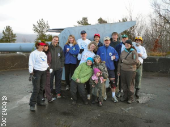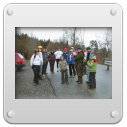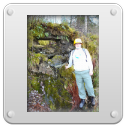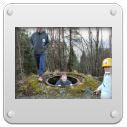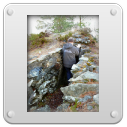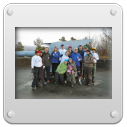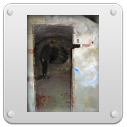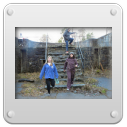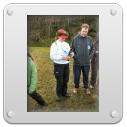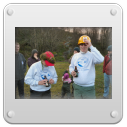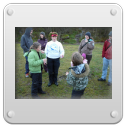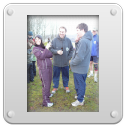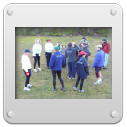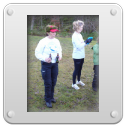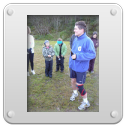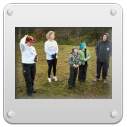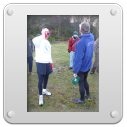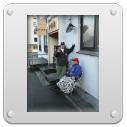Run #1 - Kvarven - 23 December 2007 - Bergen Bunker Hash House Harriers
Main menu:
Run #1 - Kvarven - 23 December 2007
Military presence at Kvarven
The run today
Welcome the first Bergen Bunker Hash House run!
The run today will take us past all three 21 cm gun positions, past what was possibly a 57 mm gun position, two of the 24 cm howitzer positions, some AA gun positions, through a few trenches, past the two Mornier munitions bunkers and past watch towers and command posts. We will not be running past the torpedo battery, as the climb through the forest from the battery to the gun positions would be a bit tough for the kiddies.
We will pass the gun which is featured on the Bergen Bunker H3 logo and is mounted in one of the 21 cm gun positions. It is not one of the original guns, but a 15 cm Kruppgeschütz mounted some yeras ago.
On on!
Kvarven
The name Kvarven is apparently from an Old Norse word referring to where ships turn and go out of sight.
1894-1914
In 1836 the institution “Central-Commissionen for Norges Befæstningsvæsen” raised the possibility of establishing permanent fortifications around Bergen. In 1850 gen.major (Major general) Broch proposed fortifications some distance from major towns in order to stop an advancing enemy before they could launch their attack on these towns.
In the late 1800’s, relations between Sweden and Norway had gradually worsened as Norway wanted independence from the union with Sweden. To account for the possibility of a violent dissolution of the union, new coastal defences were built. The three forts that formed the inner fortifications around Bergen, namely Kvarven, Hellen fort and Sandviksbatteriet, were planned and built in the period 1894-1902.
In 1894 Bergen Forsvarsforening (Bergen Defence Association) made NOK 100.000 available to start the preparation for building fortifications around Bergen. On the 20th November 1894 the Ministry of Defence gave the go-ahead to start the construction of the fortifications to defend Bergen harbour and the naval installations at Marineholmen and Wallemsviken from possible sea born attacks.
In the period 1895-97 roads, gun positions and ammunition bunkers were built on Kvarven. By 1898 three 21 cm St. Chamond L/45 canons, three 24 cm St. Chamond L/14 howitzers (all of French origin), three Cockerill 57 mm L/60 canons (Belgian) and two light machine guns had been installed at Kvarven.
In 1899 the work started on the torpedo battery by the shoreline on Kvarven. With the completion of the torpedo battery in 1902, Kvarven was regarded as being a top modern fort for its time and ready to defend Bergen from sea born attacks.
In the period 1900-05 the outer fortifications were constructed. These consisted of combined minefields and artillery, and included Herløyavsnittet (Herdlafjorden/east side of Herdla) with fortifications on Skarvøy, Ypsøy, Karlsøy and Lammøy and Håøyavsnittet (Radøyfjorden at the end of Osterfjorden) with fortifications on Lillebergen, Hagelsund, Flatøy and Glatøy plus a gun battery on Håøy.
None of the above forts came into their intended use as the union between Norway and Sweden was dissolved peacefully in 1905.
1914-1918
During the First World War, Kvarven Fort had a full complement of soldiers in order to maintain Norwegian neutrality. This is also a period when a lot of new buildings were erected including among others the Monier storage bunkers, bath facilities and a hospital.
1918-1940
In the 1920s and 1930s, a part from a few new buildings being built, not much happened at Kvarven.
At a weapon inspection in 1936 it was decided that Kvarven was within an acceptable state to defend Bergen. At the outbreak of the Second World War the fort had three 21 cm guns, three 24 cm howitzers, two 75 mm M 1916 AA-canons, two 7.92mm Colt M 1929 machine-guns, three 57 mm canons and two 110 cm searchlights in addition to the torpedo battery.
1940-1945 Norway attempted neutrality at the outbreak of the Second World War, but was invaded by Germany in the operation Weserübung on the 9th April 1940.
Norway attempted neutrality at the outbreak of the Second World War, but was invaded by Germany in the operation Weserübung on the 9th April 1940.
On the 8th April 1940, 279 soldiers and 33 officers were manning Kvarven; their average age was 40. There were no reserves, and some of the men had to endure long watches before they were relieved. Their military training was insufficient, and the fort had no units prepared for close defence. The attacking German forces on Bergen comprised of approximately 1900 troops.
The following is a description of the attack on Bergen on 9th April 1940 based mainly on a report written by the commanding officer of Bergen Festning, colonel Willoch:
At 22:00 on the 8th April the guns at Kvarven and Hellen were readied for action.
At 00:28 on the 9th April information was received indicating that enemy warships were in battle with the forts Rauøy and Bolærne in the Olsofjord.
At 01:30 Willoch received a telephone call from admiral Tank-Nielsen (commanding officer for the 2nd sjøforsvarsdistrikt (sea defence area)) informing him that 7 warships were steaming in Korsfjorden to the south of Bergen.
At 02.14 Lerøy fort (to the south of Bergen) reported that they were in action against invading warships. The fort had two 65 mm canons and fired 12 salvos possibly hitting one of the armed trawlers but without causing any damage.
The guns on both Kvarven and Hellen fort were loaded.
Reinforcements were requested from Ulven (an army camp to the south of Bergen).
At 03:50 the crew on Kvarven spotted two ships rounding the headland of Godvik. The fort held its fire as the ships were thought to be unarmed merchant vessels. They were in fact two armed German trawlers "Schiff 9" and "Schiff 18" and part of the invading forces.
The order to open fire was given at 03:59 and salvos were fired from the 21 cm guns followed by the 24 cm howitzers.
A light fog prevented the proper use of range finders and the searchlight on Kvarvenpynten was out of action as Kvarven got its electricity from civil power grid! Willoch had grudgingly agreed to a total blackout of Bergen a few hours earlier. Due to the positioning of the second searchlight on Øyarodden, it could not be used efficiently against the invading warships.
The range to the warships had to be estimated and Kvarven was only able to fire two salvoes at the cruiser "Köln" and the two torpedo boats "Leopard" and "Wolf" before the ships reached the fort's dead zone, about 1500 metres from the fort. The ships did not retaliate, but sent a Morse coded message in English saying “stop shooting!“.
One single Norwegian F.52 aircraft dropped two bombs on the ships. According to Willoch the bombs hit the targets but did not explode, other sources suggest the bombs missed their targets, but according to one of the crew on the bomber, no bombs were dropped due to technical problems.
The fort managed to get two hits on "Bremse", and one on "Karl Peters". They did not sink, but were unable to fight on (Willoch reported that “Bremse” did sink).
At 04:43 "Königsberg" was speeding into the harbour at 22 knots. The 21 cm guns missed on the first two salvoes. The third salvo hit "Königsberg" right under the waterline, and started a fire, the fourth salvo hit the deck, and the fifth salvo hit right under the conning tower. The guns on Königsberg were now returning fire and set one of the 21 cm guns out of action, as the barrel had been filled with debris when a shell from "Königsberg" exploded approx. 20 meters in front of the gun.
According to Willoch the Norwegian minelayer “Uller” sailed more or less straight through the on-going battle, forcing Hellen fort to cease firing for a while, as they could not distinguish friend from foe. Some sources mention that Hellen fort ceased firing due to a misunderstanding.
At 04:56 all guns on Kvarven had ceased firing due to technical problems. According to Willoch the guns were not able to sustain the continues firing and the sealing mechanism produced by de Bange expanded and blocked the breeches rendering the guns useless.
At 05:01 Willoch gave the order to cease firing.
The gun crews were armed in order to defend the fortress against the invading German troops.
At 06:15 after a short battle all Norwegian troops were ordered to cease firing.
The Norwegian torpedo boat "Brand" was hiding in Gravdalsbukten near the east side of Kvarven. It was a replacement for the torpedo battery, as according to Willoch, the crew needed 12 hours to ready the battery. Some sources (crew members) suggests that the range to the German warships was 700-1000 meters, and one or several hits would have been assured, still the commander chose to abandon his ship because he felt that the chance of success was so minimal that he would not risk it! The Germans captured his ship intact. Other sources (the commanding officer) suggest that the vessel was delayed and forced in to Laksevåg by German vessels and captured without a fight.
At 07:00 Willoch surrendered Kvarven to Hauptmann Müller.
According to one source, the German forces sent the following report to their headquaters in Germany "After a short battle Bergen has been occupied, minimal loses."
The German invading force (Kriegsschiffsgruppe 3 under KAdm. Schmundt) consisted of:
Leichten Kreuzern Köln (Kpt.z.S. Kretzenberg)
- Leichten Kreuzern Königsberg (Kpt.z.S. Ruhfus)
- Artillerieschulschiff Bremse (FKpt. Förschner)
- Torpedobooten Leopard and Wolf
- Schnellbootbegleitschiff Carl Peters
- S-Booten (S19 and S21 collided before reaching Bergen) S 22, S 23 and S 24
- Hilfsschiffen Schiff 9 / „Koblenz“ and Schiff 18 / „Alteland“
Killed (Norwegian):
Hestviken (just off NUTEC): 2 killed (they were captured by the Germans but killed by fire from Norwegians defending Kvarven. One source suggest that 1 soldier was killed in Hestviken and the other was killed by Germans when failing to stop when ordered as he tried to reach his post at the torpedo batteries)
Kvarven: No casualties
Hellen fort: 1 sergeant and 5 gun crew (killed by German bombers)
Injured (Norwegian):
Kvarven: 9 (one soldier died from his injuries on 8th May 1940)
Hellen: 8
Hestviken: 1
Official German loses included 9 soldiers and 10 sailors, although Willoch thought they were probably higher. Willoch also comments that he found it strange that Norwegian casualties were not greater considering the overwhelming German superiority in men and firepower as Hellen fort was attacked by German bombers, as was Kvarven in addition to being shelled by the German warships.
Salvos fired from Kvarven and Hellen:
21 cm guns on Kvarven: shots fired: 24 – hits: 8
24 cm howitzers on Kvarven: shots fired: 10 – hits: 2 or 3
21 cm guns on Hellen: shots fired: unknown – hits: 2 or 3 on “Köln” (according to some accounts Hellen fort did not hit any of its targets)
Willoch and his officers agreed that the soldiers manning Hellen fort and Kvarven were calm and efficient under fire and performed their duties in an admirable manner. He concludes that he was convinced that under different circumstances the outcome would have been very different. Willoch listed 25 things that went wrong and led to the fall of Bergen Festning (in Norwegian).
During the Second World War the only major work the Germans carried out on Kvarven, was to replace the original 45 cm torpedo tubes in the torpedo battery with German produced torpedo tubes. The 21 cm guns, 57 mm guns and torpedo battery were operational by 19th April. The 24 cm howitzers were operational shortly afterwards.
1945 to 1961
Kvarven passed back to Norwegian control in 1945, and was in service until it was closed down in 1961. The military still use part of Kvarven, but most of it is open to the public and it is today managed by Bergen og Omland Friluftsråd.
The details in the various sources vary. The differnces are mentioned in the disertation.
Sources
See the links page for the sources used for this page.

